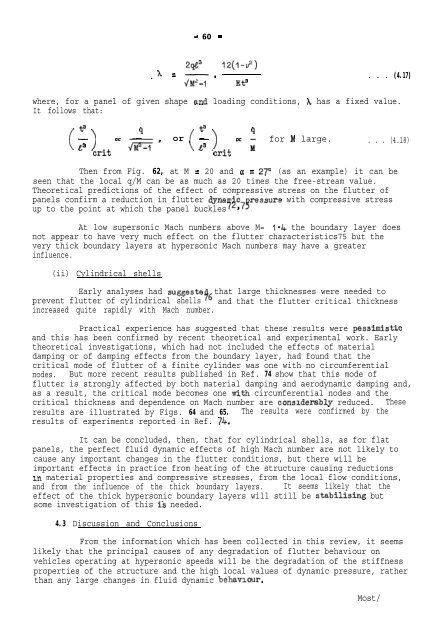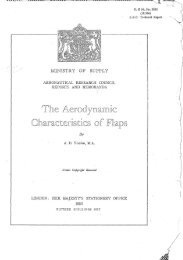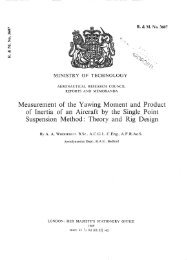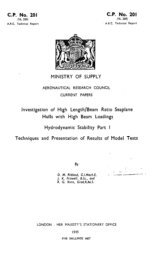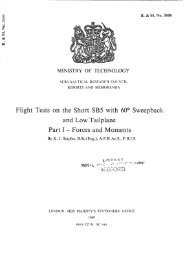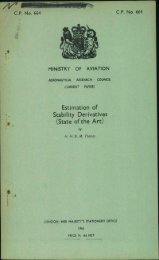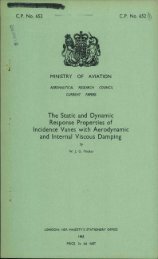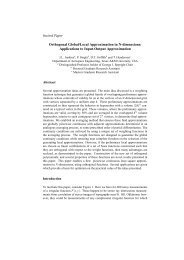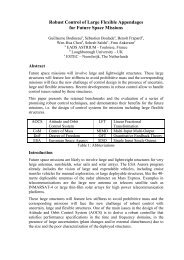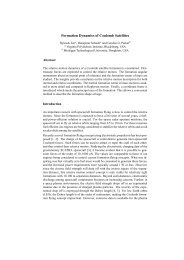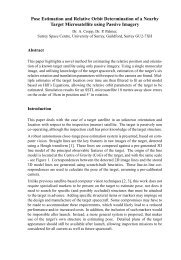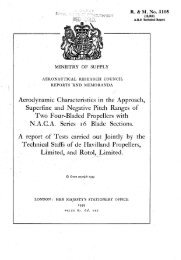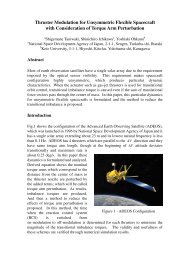A Survey of Unsteady Hypersonic Flow Problems
A Survey of Unsteady Hypersonic Flow Problems
A Survey of Unsteady Hypersonic Flow Problems
You also want an ePaper? Increase the reach of your titles
YUMPU automatically turns print PDFs into web optimized ePapers that Google loves.
- 60 -<br />
.h = -.<br />
q/MA-1<br />
w3 12(1-l?)<br />
Et?<br />
. . . (4.17)<br />
where, for a panel <strong>of</strong> given shape and loading conditions, h has a fixed value.<br />
It follows that:<br />
t3<br />
9 e<br />
-<br />
9<br />
or -<br />
( ca > cs dz' ( 8" 1 "ii<br />
orit crit<br />
for M large. . . . (4.18)<br />
Then from Fig. 62, at M = 20 and a = 27' (as an example) it can be<br />
seen that the local q/M can be as much as 20 times the free-stream value.<br />
Theoretical predictions <strong>of</strong> the effect <strong>of</strong> compressive stress on the flutter <strong>of</strong><br />
panels confirm a reduction in flutter dyna ressure with compressive stress<br />
up to the point at which the panel buckles4T79 .<br />
At low supersonic Mach numbers above M= l-4 the boundary layer does<br />
not appear to have very much effect on the flutter characteristics75 but the<br />
very thick boundary layers at hypersonic Mach numbers may have a greater<br />
influence.<br />
(ii) Cylindrical shells<br />
Early analyses had suggeste 46 that large thicknesses were needed to<br />
prevent flutter <strong>of</strong> cylindrical shells and that the flutter critical thickness<br />
increased quite rapidly with Mach number.<br />
Practical experience has suggested that these results were pessimistio<br />
and this has been confirmed by recent theoretical and experimental work. Early<br />
theoretical investigations, which had not included the effects <strong>of</strong> material<br />
damping or <strong>of</strong> damping effects from the boundary layer, had found that the<br />
critical mode <strong>of</strong> flutter <strong>of</strong> a finite cylinder was one with no circumferential<br />
nodes. But more recent results published in Ref. 74 show that this mode <strong>of</strong><br />
flutter is strongly affected by both material damping and aerodynamic damping and,<br />
as a result, the critical mode becomes one with circumferential nodes and the<br />
critical thickness and dependence on Mach number are considerably reduced. These<br />
results are illustrated by Figs. 64 and 65. The results were confirmed by the<br />
results <strong>of</strong> experiments reported in Ref. 74.<br />
It can be concluded, then, that for cylindrical shells, as for flat<br />
panels, the perfect fluid dynamic effects <strong>of</strong> high Mach number are not likely to<br />
cause any important changes in the flutter conditions, but there will be<br />
important effects in practice from heating <strong>of</strong> the structure causing reductions<br />
in material properties and compressive stresses, from the local flow conditions,<br />
and from the influence <strong>of</strong> the thick boundary layers. It seems likely that the<br />
effect <strong>of</strong> the thick hypersonic boundary layers will still be stabilising but<br />
some investigation <strong>of</strong> this i‘s needed.<br />
4.3 Discussion and Conclusions<br />
From the information which has been collected in this review, it seems<br />
likely that the principal causes <strong>of</strong> any degradation <strong>of</strong> flutter behaviour on<br />
vehicles operating at hypersonic speeds will be the degradation <strong>of</strong> the stiffness<br />
properties <strong>of</strong> the structure and the high local values <strong>of</strong> dynamic pressure, rather<br />
than any large changes in fluid dynamic behaviour.<br />
Most/


